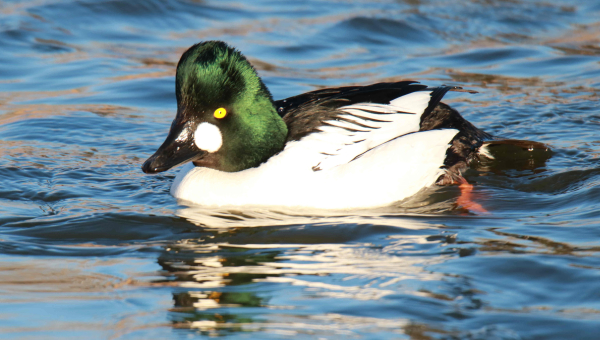
Photographing during winter in the Dakotas requires some special equipment and a certain amount of guts. That is, you literally need to throw caution to the wind, so to speak, with a “Just do it” attitude. Any time you drive into the wilds of Dakota country during December, January, and February, there is a certain degree of danger involved. Ice, extreme cold, blowing snow, suicidal deer, and the usual vehicle breakdowns that can happen anytime are the most obvious dangers, and they all increase exponentially in the dark – and return trips home after a day of birding tend to be after sunset.
But when you grow up with these winter variables, and return to it as an adult, you have a level of “this is how living in Dakota is – just like living in Alaska or Upstate New England during winter; or in the Mojave Desert of California and Nevada, or the Sonoran Desert of Arizona during the summer sizzle. So we prepare, and we are ready for potential dangers; and to an extent, we may rely on the services and aid of fellow Dakotans if an emergency arises.
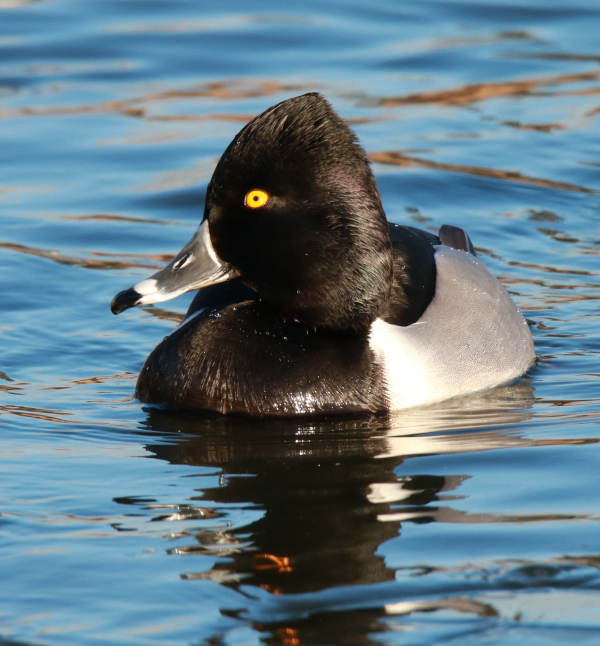
Just the same, before first light Thursday morning, with the temperature at minus 21, every bit as important as my photo equipment was my personal “emergency weather kit” for my vehicle and me, which includes 2 tubs of equipment filled with tools, extra clothing, food, water, and survival gear, plus a floor jack and my cellphone. After all, a new vehicle can break down, get a flat tire, or get hit by a deer, as can any other dependable car, truck, or van.
Normally I probably would have passed on an extended birding trip with the weather prediction for extremely low temperatures and more wind than I prefer for good birding conditions, but a narrow opportunity to photograph in abundant sunshine dictated my great desire to hit the road with my camera. Then too, I admit to a bit of “cabin fever,” which was really more a matter of “birding fever.” I had been waiting for a sunny day in the Pierre area, to return to my SoDak winter raptor hotspot that holds the additional attraction of impressive wintering ducks.
The weather forecast for last Thursday looked promising, in spite of the minus 20 degree temperatures and winds between 10 and 15 miles per hour, which I hoped would be 10mph or less. Knowing the weeks I’ve been waiting for the sun, and looking ahead at the lack of sunshine for the rest of the month, I figured even if it wasn’t a great day for birds of prey, the bottom line was that I wanted to return to photograph ducks.
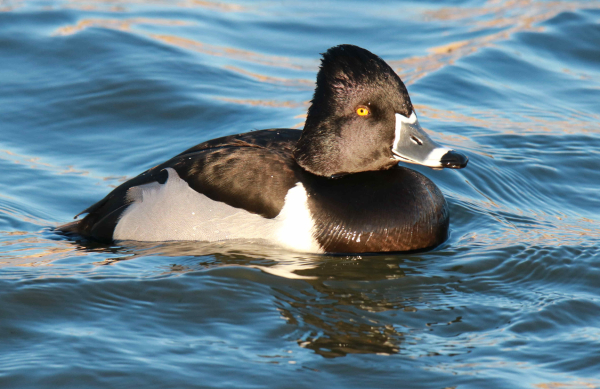
Cold Water Ducks
I knew the real excitement might be the chance to photograph any of the exciting ducks I found during my last visit to the area 3 weeks earlier. And when I arrived Thursday morning without a cloud in sight, I was glad to see there was still some open water – and some colorful cold-weather ducks remaining. Although the 4 Wood Ducks apparently left for warmer waters, the other species were present, with some additions – most notably more male Ring-necked Ducks (6), a few more Hooded Mergansers (11), and a considerable majority of Mallards. There were also 4 Canvasbacks (2 females, 2 males), a dozen Redheads, and a few Common Mergansers, but these species kept a prohibitive distance for photos. Even so, a trusting male Goldeneye, the Ring-necks, and the Hoodies provided ample thrills before my camera.
Each duck that swam within range provided lively looks into their species, and insights into their colors and behaviors. Every one was captivating as I appreciated viewing them through the magnification of my zoom lens. I could study how the sun flashed colors on iridescent plumage when they turned a certain way, and how their feathers dulled in the shadows.
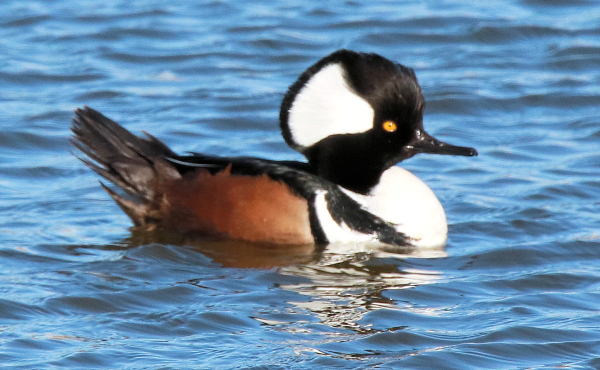
It was especially exciting when a drake Hooded Merganser finished it’s preening session by expanding its feathered hood, even though the photographer wished the Hoodie was closer – a common wish among bird photographers.
|
However, the combination of the frigid temperature and wind made it especially hard to spend much time outdoors – only 8 to 10 minutes at a time in the late morning when the temperature had only warmed to 6 degrees during my first photo sessions, to 10 degrees during my second session an hour later, and 16 degrees during late afternoon, when I was able to spend about 20 minutes outside to take advantage of the last moments of ample sunlight before the pending sunset.
Believe me, I tried to extend my time outside, even folding my fingers into a fist inside my gloves to warm these appendages and extend my time, and by keeping my hood up and my back to the wind as much as possible, but I doubt I gained more than an extra minute using these strategies – but that may have provided the time to get ever-better photos of any ducks within photo range. Each time I ventured outside I was lucky enough to have some ducks within relatively close range so I could make the most of my limited time photographing them.
Usually I emphasize raptor time, which means I only make one short stop at the pond, but after my last fun stop at this winter waterfowl hotspot, the ducks were at the top of my list this time. With fewer raptors and less photo time for eagles and hawks, I had more time, and made the most of a late afternoon return to the edge of the pond to take advantage of the last 20 minutes of good photo light before sunset on the edge of the Missouri River.
I often use my zoom lens, the Tamron 150-to-600mm zoom lens, at its full magnification, but I found that the ducks provided ample opportunities to zoom in and out, using the versatile lens to frame and compose photos. This was especially the Common Goldeneye and Ring-necked Ducks that were more trusting and actually approached this photographer from time to time. Throughout my photo sessions with the ducks I tried to emphasize taking action photos, but there was a distinct lack of action and interaction, probably a consequence of the extreme cold.
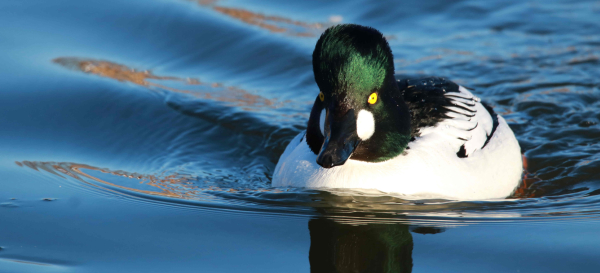
At one point during late afternoon, my autofocus stopped working, which I attributed to the extended period I spent in the ultra-cold wind. I quickly switched to manual focusing mode, which was a test for me while using winter gloves to try to keep up with the swimming action of the closest ducks. I didn’t have great luck adjusting to the gloved manual mode during the minute or 2 I tried, so switched back to autofocus – and it worked! I was back in business with the autofocus allowing me to concentrate on the activities of various ducks, and composing photos while zooming in and out as warranted.
As the sunlight was slipping away and I was searching for the last couple photo opportunities, I especially remember a wonderful feeling of elation that only comes when the birds, the camera, the light, and the moment come together with the understanding that I have had some success and enjoyed the process in a big way. Even though the journey started in subzero temperatures before first light, and culminated on the edge of freezing water among cold-weather ducks at the northern extreme of their winter range, it was all pretty wonderful, but I think I’d opt for ducks wintering on a palm tree-lined emerald water beach in a semi-tropical setting all the more.
It was obviously about the ducks too. There is something about photographing ducks that has always been attractive for me, especially when it’s possible to gain their trust and study their activities. Wherever you are, I hope you have a chance to seek out some interesting waterfowl to photograph amid tranquil blue waters.
Article and photographs by Paul Konrad
Share your bird photos and birding experiences at editorstbw2@gmail.com